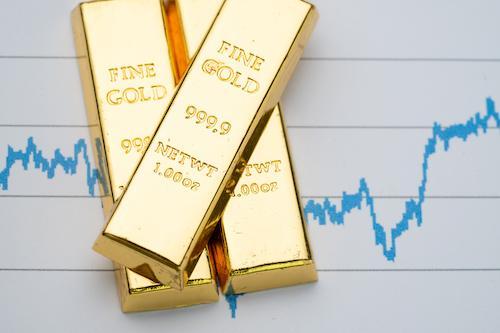
May Mania Points Gold Price Back at $2,000
The gold price rose by around 7% in May, after a couple of weak months had set the price back well behind earlier expectations. A similar rise in June would likely lead to $2,000 gold again, but there are signs of resistance to a strong upwards move now that the start-of-the-year price level has been surpassed. Therefore, it seems likely that gold’s positive trajectory this month may be progressing a little slower, although it is still trending upwards.
But there’s no doubt that May was an extremely positive month for precious metals prices. At the moment, gold is probably being driven by U.S. economic and employment data, with some significant pointers due this week. Employment doesn’t seem to be rising as hoped, which indicates that many sectors of the economy, thanks to impacts from the coronavirus, are proving extremely slow to rebound to pre-pandemic levels. Some sectors may not even recover for a couple of years yet, at the very earliest. The U.S. government’s support for people out of work as a result of the coronavirus is also seen by some as a hindrance to new job take-up. It is claimed that those receiving expanded unemployment benefits are, in some cases, taking home as much money as, or more than, they would if they were employed. One would assume that this situation will be rectified once this perhaps over-generous unemployment support level winds down in September.
But the principal point of economic uncertainty revolves around inflation perceptions, and whether these perceptions will necessitate the Fed taking action to reduce inflation levels by cutting back its quantitative easing program, or raising interest rates, or both. So far, the Fed has been adamant that its priority is to bring unemployment down to its pre-pandemic level and argues that the best way of achieving this is to keep interest rates ultra-low. It also advocates for continuing with its current QE program, which includes buying some $80 billion worth of bonds and $40 billion worth of mortgage-backed securities each month.
The Fed is probably reluctant to “rock the economic growth boat” by tapering its position in the markets. Indeed, it will be under pressure not to do so by the Biden administration, which will be anxious about any economic gains continuing in a positive direction. As we have commented before, the appointment of former Fed chair, Janet Yellen, as Treasury Secretary, could be seen as an attempt to align Fed and government policies more closely, despite the former’s supposed independent position.
Previous Fed tapering attempts have resulted in sharp downturns in U.S. and global equity prices, which is something this administration would be reluctant to see. If such an economic downturn were to come about, it could probably be seen as the most overt indicator that the economy is not recovering as fast as the government would like to claim, despite the coronavirus case and death tolls falling sharply, as the now-impressive vaccination program is rolled out across the nation.
From a European standpoint, U.S. politics looks to be in a particularly precarious state at the moment. With the stock market seemingly poised on a knife’s edge, given, by historic standards, it may be hugely overvalued, if it were to turn down sharply, the country could see a change in electoral sentiment, which may very well result in the Democratic Party losing control of one, or even both, Congressional houses during next year’s mid-term elections. Should the equities market crash in a similar fashion to the, in this writer’s opinion, overhyped and hugely overvalued Bitcoin, the Democrats could easily lose their electoral advantage because of cratering public sentiment regarding the economy.
Overall, though, despite some potential headwinds, gold looks well set for further advances. Assuming it can retain its plus-$1,900 base, the return of the gold ETFs to record inflows, rather than the heavy outflows of Q4 2020 and Q1 this year, suggests a significant change in sentiment that will overflow into silver positivity, too. There are indications that central bank interest in gold has turned more positive, too, which should be gold supportive. So too should the announcement that Russia is also paving the way to invest portions of its sovereign wealth fund in gold, which could help replace some of the nation’s previous central bank buying. This buying ceased in April and accounted, at the time, for the largest national central bank gold purchasing program.
The writer is less certain about the future for platinum group metals (PGMs), though. These are very much industrial metals nowadays, but given both palladium and platinum seem to be in a supply deficit for the moment, their prices should remain strong in the short term. Their demand is very much dependent on automobile manufacturing and sales, and as long as the U.S. economy remains in growth mode, the auto market should remain positive. However, a new report suggests that the growth in electric vehicle (EV) market share will occur far faster than had been previously predicted, citing plans from a number of manufacturers to cease production of internal combustion engine-powered light vehicles by early in the next decade. Pure EVs do not need palladium, so that particular market is likely to fall away almost completely in the next 10 years or so. The metal probably still has some good price years ahead, but long-term, its price is very vulnerable.
The gold price, and prices of the other precious metals, remain largely dependent on U.S. markets for their immediate futures. If gold’s $1,900 level holds for the remainder of this week, the prospects look good. However, we don’t anticipate the gold price achieving $2,000 this month. Back in December, just before Christmas, this writer had predicted a $2,150 price level for the end of June (see: Christmas cheer for gold and silver). There remains a chance that the forecasted gold price level could be reached, but if price rises are slowing, as currently expected, this height may not quite be managed. Nevertheless, things for gold are still looking fairly positive for the moment. The silver price prediction of $31 still looks a little out of reach, though.
The next Federal Open Market Committee (FOMC) meeting in a couple of weeks will likely see some up-and-down fluctuations as ensuing statements are digested by the media, but we don’t see the Fed changing course significantly. Plus, assuming the Fed maintains interest rates at their current extremely low levels, one should expect continuing gold price strength well into the northern hemisphere’s summer months.






